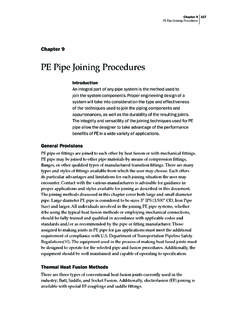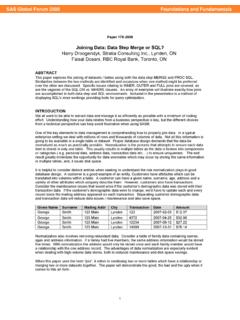Transcription of Joining of Plastics and Composites
1 UNESCO EOLSSSAMPLE CHAPTERSWELDING ENGINEERING AND TECHNOLOGY - Joining of Plastics and Composites - Mladen Sercer, Pero Raos Encyclopedia of Life Support Systems (EOLSS) Joining OF Plastics AND Composites Mladen Sercer Faculty of mechanical Engineering and Naval Architecture, University of Zagreb, Croatia Pero Raos Mechanical Engineering Faculty, University of Osijek, Croatia Keywords: polymers, Plastics , Composites , hot tool welding, hot gas welding, extrusion welding, induction welding, resistance welding, ultrasonic welding, vibration welding, spin welding, laser welding, dielectric welding, microwave welding.
2 Contents 1. Introduction 2. Polymers 3. Polymeric materials welding 4. Hot tool welding 5. Hot gas welding 6. Extrusion welding 7. Induction welding 8. Resistance welding 9. Ultrasonic welding 10. Vibration welding 11. Spin welding 12. Infrared/laser welding 13. Dielectric welding 14. Microwave welding 15. Welding of Plastics micro- and nano-components 16. Welds evaluation and testing 17. Conclusion Glossary Bibliography Biographical Sketches Summary The use of polymeric materials is nowadays increasingly in a many important applications including packaging, building, appliance, electronics, automotive, aerospace and much more.
3 Polymers already have a range of applications that far exceeds that of any other class of material available. Joining is a critical step in the manufacture of components from polymers and polymeric Composites . As the requirements for the component increase, so do the requirements for Joining , especially in structural applications. The methods for Joining Plastics and Composites can be divided into three major categories: mechanical fastening, adhesive and solvent bonding, and welding.
4 Welding is an effective method of permanently Joining plastic UNESCO EOLSSSAMPLE CHAPTERSWELDING ENGINEERING AND TECHNOLOGY - Joining of Plastics and Composites - Mladen Sercer, Pero Raos Encyclopedia of Life Support Systems (EOLSS) components. There are various welding methods. By reviewing and comparing all commercially available welding processes, this text helps the reader select the best-suited process for the application and provides an understanding on the limitations and benefits of each process.
5 The focus on practical aspects such as weldability, and testing makes this text an indispensable tool for everyone involved in welding of Plastics . At the same time, it also conveys the basic theoretical principles of Plastics welding such as squeeze flow, molecular diffusion, and heat transfer mechanisms. Each section of this chapter was developed with information dealing with basic welding aspects including materials, process phenomenology, equipment, and joint design.
6 While not all encompassing, the text provides the basic information along with references that can be used to gather additional information or details. 1. Introduction The use of polymeric materials is nowadays increasingly in a many important applications including packaging, building, appliance, electronics, automotive, aerospace. Already around 1983 the world s yearly volumetric consumption of polymers exceeded the volumetric consumption of iron and steel.
7 The worldwide polymers production in 2006 reached 300 million tons. Polymeric materials have many advantages including: high specific strength (strength/density ratio), high specific modulus (modulus/density ratio), design flexibility, reduced manufacturing costs, excellent corrosion, solvent and environmental resistance, thermal and electrical insulation, durability etc. Nowadays, there are thousands of grades of polymers available at the market. These cover a wide range of properties, from soft to hard, ductile to brittle, and weak to tough.
8 The wide variety of polymers and polymeric Composites makes it possible to select and even customize the material to the specific application. Therefore, these materials are being used in more and more applications under more and more stringent requirements. Continuing efforts in discovering new polymers as well as modifying existing polymers to create new material combinations further increases the potential uses of these materials. In polymer engineering, the design of a one-piece item for molding is the ideal situation because it precludes an assembly operation.
9 However, mechanical limitations and other considerations often make it necessary to join polymeric parts, either to each other or to other polymeric or metallic parts, to complete the assembly. In such instances, the Joining process can be an efficient production technique if a few precautions are taken and established procedures are followed. Joining is a critical step in the manufacture of components from polymers and polymeric Composites . As the requirements for the component increase, so do the requirements for Joining , especially in structural applications.
10 Joints are necessary always when: part integration is impossible because of complexity and/or high costs, using different materials in the same component, disassembly is required, and repair of damage is needed. UNESCO EOLSSSAMPLE CHAPTERSWELDING ENGINEERING AND TECHNOLOGY - Joining of Plastics and Composites - Mladen Sercer, Pero Raos Encyclopedia of Life Support Systems (EOLSS) Joining is generally the final step in any fabrication cycle. The effectiveness of the Joining operation can have a large influence on the application of any polymer or composite material.


















